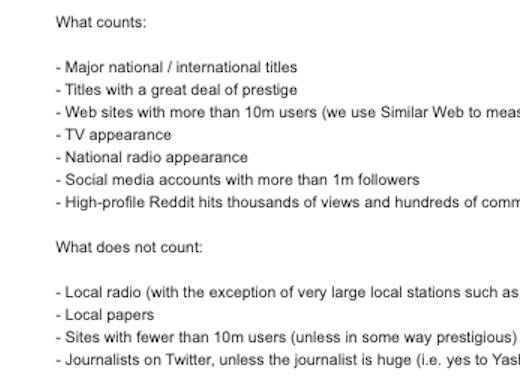Substack, Media Fragmentation & PR
How the Explosion in News Creators impact Communications Pros
It was inevitable. The ability to profit from a personal news brand through the creation and distribution of original content has gotten even easier. “We the media” started 15+ years ago with CGM/blogging and, to a lesser degree, podcasting and has evolved to the point where established journalists (with decent social followings) are jettisoning prestige jobs at venerable news organizations to go it alone. (They should also thank their employers on the way out for facilitating their large followings.)
Ben Smith, David Carr’s most worthwhile successor at The New York Times, explores the rise of new content-distribution platforms that pave the way for anyone with something to say and a dedicated following to earn a living wage. In addition to Substack, other emerging publishing platforms include Ghost, Outpost, Revue, and Lede. Smith writes:
Substack has captivated an anxious industry because it embodies larger forces and contradictions. For one, the new media economy promises both to make some writers rich and to turn others into the content-creation equivalent of Uber drivers, even as journalists turn increasingly to labor unions to level out pay scales.
Such prominent breakaway journalists include Casey Newton, Jessica Lessin, and Graydon Carter who respectively left The Verge, The Wall Street Journal, and Vanity Fair to start their own subscription-based newsletters. Newton’s six-month-old Platformer reportedly now has 20,000 subscribers (at $10/month). In contrast, Lessin’s The Information has many more than that (at $39/month for professionals). The Information is considered one of the most influential tech news media brands today, constantly breaking big stories.
Meanwhile, Sara Fischer who writes for another similarly-started news org Axios today reports that former VF editor Graydon Carter’s AirMail newsletter, launched in 2019, expects to employ 40 people by year's end, up from 30 today.
And we just learned that Charlie Warzel is leaving his highly influential perch on The New York Times’s Opinion pages to start a premium Substack-based newsletter called Galaxy Brain. He explains:
I often lament that I missed the golden era of blogging. I adored the informal, conversational experience — but also the way in which so much of what I read was curious and iterative, instead of defensive and definitive. A lot of those heyday bloggers have told me that they loved building up running conversations with their audience — really knowing them. They were people, not page views. And right now, I’m tired of my audience feeling like an abstraction.
Whatever the reasons - money, editorial independence, dopamine rush, ego - the proliferation of journalist-driven newsletters and podcasts (like Pivot), not to mention the universe of commercially supported influencers minting money on TikTok, Instagram, and YouTube, has made life hell for PR people tasked with building a positive, branded media footprint for their clients.
While the number of outlets (to pitch) has exploded, long gone are the days when a single news story in a legacy outlet can drive the national news agenda and conversation. Even the most consequential investigative reporting no longer enjoys the longevity and influence it once had.
Don’t get me wrong. “Earned media,” i.e., editorial coverage, remains the most effective marcomms discipline for creating awareness and action, IMHO. It also is the most mal-practiced. Crafting a news release with the hope that some beleaguered journalist will engage to the point of penning a story based on it is a fool’s errand. Unless, of course, you work for one of the companies that journalists obsess over like Google, Netflix, Amazon, Facebook, or Apple. Sadly, most of us do not.
Journalists nowadays get the vast majority of their story ideas, not from PR pros who suffocate reporters with superfluous story pitches at a ratio of 10:1, up from 6:1 just a few years ago, but organically on Twitter, Clubhouse, and Slack. It’s clearly not from a random pitch crossing an email inbox, no matter how provocative the subject line. That said, the sender's name recognition can sometimes determine whether the journalist will even open the email.
If stories germanate organically, what’s a PR person to do? For starters, he/she/they have to fish where the fishes swim, i.e., actively engage in the channels where journalists reside. This, of course, includes Twitter and Clubhouse. Still, there are myriad communities on Slack and other private sub-channels and again soon physical gatherings that newsletter proprietors offer to their paid subscribers. To not engage as such would be considered today as PR malpractice.
How one measures PR success also has evolved with the changing media landscape. It’s no longer a matter of tallying the outlet’s number of readers, listeners, or viewers, even though most corp comms departments continue to rely on this metric to validate their value to the enterprise. Engagement, social amplification, and the quality/influence of those who see the piece are the new norms.
In fact, the editor of Insider just let the idea of “impact points” slip into the public domain. He described it as “a qualitative metric that some publications use to track whether a story made it in front of the right people, so to speak.” He went further to break out “who counts as a strategic mouthpiece and who does not: yes to major publications, TV appearances, and high-profile Reddit threads; no to local radio, local papers,” and, famously, The Daily Beast’s Max Tani, who broke this news to his (apparently paltry) 36,000 followers on Twitter.
The explosion in the number of premium newsletters, podcasts, and digitally native sites to which I’d like to subscribe will certainly break my annual media budget, let alone consume whatever leisure time I may still have.
Already I’m on the hook for Bloomberg News, The New York Times, the Washington Post, The Wall Street Journal, The LA Times, The Information, Vanity Fair, The New Yorker, The Daily Beast, Insider, New York Mag, and a few others. This is in addition to the free newsletters from Axios’s Sara Fischer and Dan Primack, Judd Legum’s Popular Info, Eric Boehlert’s Press Run, CJR’s Mathew Ingram, Andrew Ross Sorkin’s Dealbook, Politico Playbook, Punchbowl News, Vox Sentences, Jason Hirschorn’s Media REDEF, Brian Stelter/CNN’s Reliable Sources, Quartz Daily Brief, The Skimm, and many others.
Then there are the podcasts such as Kara Swisher and Scott Galloway’s Pivot and their individual ventures The Prof G Show and Sway, VF’s Inside the Hive with Emily Jane Fox and Joe Hagan, Peter Kafka’s Recode Media, Michael Barbaro/NYT’s The Daily, The New Abnormal with Molly Jong-Fast and Rick Wilson, Sarah Kendzior and Andrea Chalupa’s Gaslit Nation, and anything from Virginia Heffernan (@Page88).
Something’s gotta give. How much more media fragmentation can a voracious news consumer (like myself) endure and afford?









